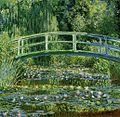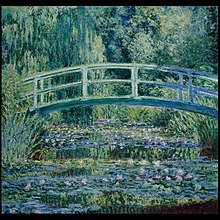Plik:Water-Lilies-and-Japanese-Bridge-(1897-1899)-Monet.jpg
Wygląd

Rozmiar podglądu – 617 × 599 pikseli. Inne rozdzielczości: 247 × 240 pikseli | 494 × 480 pikseli | 791 × 768 pikseli | 1031 × 1001 pikseli.
Rozmiar pierwotny (1031 × 1001 pikseli, rozmiar pliku: 381 KB, typ MIME: image/jpeg)
Historia pliku
Kliknij na datę/czas, aby zobaczyć, jak plik wyglądał w tym czasie.
| Data i czas | Miniatura | Wymiary | Użytkownik | Opis | |
|---|---|---|---|---|---|
| aktualny | 22:57, 19 sty 2009 |  | 1031 × 1001 (381 KB) | Krscal | {{Information |Description={{en|1=Water Lilies and Japanese Bridge (1897-1899) by Claude Monet Princeton University Art Museum}} |Source=the-athenaeum.org http://www.the-athenaeum.org/art/full.php?ID=3788 |Author=Claude Monet |Date=1897-1899 |Permission= |
Lokalne wykorzystanie pliku
Następujące strony korzystają z tego pliku:
Globalne wykorzystanie pliku
Ten plik jest wykorzystywany także w innych projektach wiki:
- Wykorzystanie na ceb.wikipedia.org
- Wykorzystanie na cs.wikipedia.org
- Wykorzystanie na cy.wikipedia.org
- Wykorzystanie na en.wikipedia.org
- Wykorzystanie na en.wikivoyage.org
- Wykorzystanie na et.wikipedia.org
- Wykorzystanie na fr.wikivoyage.org
- Wykorzystanie na ja.wikipedia.org
- Wykorzystanie na kbp.wikipedia.org
- Wykorzystanie na lv.wikipedia.org
- Wykorzystanie na pt.wikipedia.org
- Wykorzystanie na ro.wikipedia.org
- Wykorzystanie na sl.wikipedia.org
- Wykorzystanie na sq.wikipedia.org
- Wykorzystanie na sv.wikipedia.org
- Wykorzystanie na ta.wikipedia.org
- Wykorzystanie na vi.wikipedia.org




